|
|
|
Sort Order |
|
|
|
Items / Page
|
|
|
|
|
|
|
| Srl | Item |
| 1 |
ID:
107489
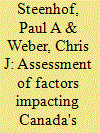

|
|
|
|
|
| Publication |
2011.
|
| Summary/Abstract |
In this article we develop and then implement a decomposition model of Canada's electricity sector in order to assess multiple factors impacting on trends in greenhouse gas emissions from the sector, with a focus on the impact of climate and energy policy on emissions for the time period spanning from 1990 to 2008. The analysis shows that during these years, the primary factors driving changes in emissions included changes in electricity demand, changes in the generation mix of electricity, and weather, but that government policy and programs had only minor impacts on emissions. Although having relatively lesser impacts compared to the aforementioned factors, the most significant policy related factors included efforts to increase renewables in the generation mix through programs such as renewable portfolio standards and incentives for wind generators.
|
|
|
|
|
|
|
|
|
|
|
|
|
|
|
|
| 2 |
ID:
150443
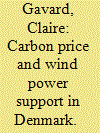

|
|
|
|
|
| Summary/Abstract |
This paper aims at characterizing the conditions of wind power deployment in order to infer a carbon price level that would provide wind power with comparable advantage over fossil fuel technologies as effective wind support policies. The analysis is conducted on Denmark after the electricity market liberalization. Probit and tobit techniques are employed to take account of a potential threshold effect. I find that the level and type of the support policy are the dominant drivers of deployment. A feed-in tariff significantly brings more wind power in than a premium policy. The additional capacity installed monthly increases by more than 1 MW for each additional €/MWh of support. This is compared to the effect of the electricity price, investment cost, interest rate and general economic activity. If the policy is a premium, I find that 23€/MWh of support in addition to electricity price is needed to observe the connection of new turbines to the grid with a 0.5 probability. I convert this support level into a carbon price of 27€/ton if wind power competes with coal, and 48€/t if it competes with gas.
|
|
|
|
|
|
|
|
|
|
|
|
|
|
|
|
| 3 |
ID:
150656
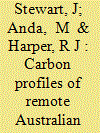

|
|
|
|
|
| Summary/Abstract |
A decision-making model was constructed to assist remote Australian Indigenous communities select appropriate climate change mitigation programs. The Resilient Community and Livelihood Asset Integration Model (ReCLAIM) comprises six steps that focus on community assets and aspirations. The second of these steps is to determine the baseline carbon profiles of communities based on six sources of carbon emissions: materials, construction processes, stationary energy, transport, water systems and waste. The methodology employed an annualised lifecycle analysis of housing materials and construction, and an annual inventory of other emission sources. Profiles were calculated for two remote communities and compared to the Australian average and also average electricity consumption by remote communities in the Northern Territory.
|
|
|
|
|
|
|
|
|
|
|
|
|
|
|
|
| 4 |
ID:
116955


|
|
|
|
|
| Publication |
2012.
|
| Summary/Abstract |
China is the largest coke producer in the world, accounting for over 60% of the world coke production, which makes the coke industry in China a significant coal consumer and air pollutant emitter. Recently, China has taken a series of measures to improve energy efficiency and reduce emissions from the coke industry, including eliminating old and low energy-efficiency coking technologies, promoting advanced technologies, and strengthening energy and environmental requirements on coking processes. As a consequence, China's coke industry is experiencing an unprecedented technology shift, which was characterized by the elimination of old, inefficient, and polluting indigenous ovens and small machinery ones within 10 years. This study examines the policies and the prompt technology shift in China's coke industry, as well as the associated energy and environmental effects, and discusses the implications with respect to the development of the coke industry in China towards a more efficient and clean future. As China sets stricter requirements on energy efficiency and the ambient environment, a more significant change focusing on technologies of energy saving and emission reduction is urgently needed at present. Those mature technologies, including coke dry quenching, coke oven gas recycle, fine particle removal, etc., should be enforced in the near future.
|
|
|
|
|
|
|
|
|
|
|
|
|
|
|
|
| 5 |
ID:
104974


|
|
|
|
|
| Publication |
2011.
|
| Summary/Abstract |
The recent failure of Copenhagen negotiations shows that concrete actions are needed to create the conditions for a consensus over global emission reduction policies. A wide coalition of countries in international climate change agreements could be facilitated by the perceived fairness of rich and poor countries of the abatement sharing at international level. In this paper I use two popular climate change integrated assessment models to investigate the path and decompose components and sources of future inequality in the emissions distribution. Results prove to be consistent with previous empirical studies and robust to model comparison and show that gaps in GDP across world regions will still play a crucial role in explaining different countries contributions to global warming.
|
|
|
|
|
|
|
|
|
|
|
|
|
|
|
|
| 6 |
ID:
162325


|
|
|
|
|
| Summary/Abstract |
Both multi-person households and dense urban areas reduce per capita carbon dioxide (CO2) emissions by enabling people to share carbon-intensive goods within and between households. In this paper we estimate these household and urban economies in CO2 emissions using detailed household expenditure data for the United States. We then decompose these economies into their primary sources and investigate any potential rebound effects, or diseconomies. The results show that the bulk of household and urban economies come from reductions in emissions from residential energy use and private vehicle transportation. We also find some evidence of rebound effects, with both residential density and multi-person households increasing expenditures on air travel and restaurant meals in particular. These effects are small in comparison to the size of total net economies, suggesting that fears of large rebound effects or backfire effects may be overstated. These results further suggest that policies targeted at the provision of social and technological infrastructure, such as public transportation, mixed-use zoning, and public internet may be most effective in reducing the rural-urban divide in private vehicle emissions.
|
|
|
|
|
|
|
|
|
|
|
|
|
|
|
|
| 7 |
ID:
171517


|
|
|
|
|
| Summary/Abstract |
One important and frequently-raised issue about foreign direct investment (FDI) is the potentially negative consequences for the environment. The potential environmental cost due to increased emissions may undermine the economic gains associated with increases in FDI inflow. Although the literature is dominated with this adverse view of FDI on the environment, there is also a possibility that FDI can contribute to a cleaner environment, especially, if FDI comes with green technologies and this creates spillovers for domestic industries. Theoretically, the effect of FDI on the environment can be negative or positive. To deal with the theoretical ambiguity about the FDI-environment nexus, many empirical studies have been conducted but their results only reinforce the controversy as they produce contrasting results. We conduct a meta-analysis of the effect of FDI on environmental emissions using 65 primary studies that produce 1006 elasticities. Our results show that the underlying effect of FDI on environmental emissions is close to zero, however, after accounting for heterogeneity in the studies, we find that FDI significantly reduces environmental emissions. Results remain robust after disaggregating the effect for countries at different levels of development as well as for different pollutants.
|
|
|
|
|
|
|
|
|
|
|
|
|
|
|
|
| 8 |
ID:
179722
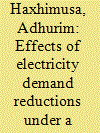

|
|
|
|
|
| Summary/Abstract |
The coronavirus pandemic (COVID-19) has led to a massive collapse in economic activity and energy demand, with the result of significant emissions reductions at a global scale. However, the existing literature investigating abatement from COVID-19 mainly overlooked the overwhelming emissions reduction in Europe's power sector. We address this by assessing the intricate relationship between electricity demand shocks and heterogeneous generation technologies in the power sectors of 16 major European economies during January to March 2020. We apply an econometric model in an instrumental-variables framework. In a first step, we assess the impact of COVID-19 infections on electricity demand, and in a second step how this translates into emissions abatement. We find that, during full lockdown, COVID-19 reduced electricity demand by 19% and carbon emissions by an astonishing 34% per hour, whereas there is severe country heterogeneity depending on the electricity supply structure and demand shock intensity. From our estimates, we predict that power sector emissions fell by 18.4% in 2020. Our results reveal the importance of a carbon price, so that a demand reduction can offset large amounts of emissions by displacing coal at the margin. We derive several policy implications from our analysis to draw lessons from the pandemic.
|
|
|
|
|
|
|
|
|
|
|
|
|
|
|
|
| 9 |
ID:
092769
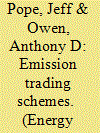

|
|
|
|
|
| Publication |
2009.
|
| Summary/Abstract |
The case for the imposition of carbon (emission) taxes or tradable carbon permits in important tax jurisdictions is arguably strong, based upon the polluter pays principle first proposed by Pigou almost a century ago. This paper briefly reviews the arguments for and against these market-based instruments, and discusses their relative advantages and disadvantages in a practical context. In the case of Australia, the revenue effect of the proposed tradable carbon permits scheme is estimated to be A$11.5 billion in 2010-11. For comparison, this is roughly equivalent to a quarter of the revenue from the Goods and Services Tax. The paper focuses on three neglected aspects of climate change taxation discussion to date: how much tax revenue is likely to be raised, and the administrative and compliance costs of an emissions trading scheme, with particular reference to Australia. In discussing these issues, the paper draws upon selected and relevant international experience, particularly the European Union emissions trading scheme. The challenges of an emissions trading scheme, including integration with the existing tax system, particularly in an Australian context, are also discussed. The paper concludes by emphasising the key challenges and issues facing this 'ultimate externality' debate, particularly from a taxation policy perspective.
|
|
|
|
|
|
|
|
|
|
|
|
|
|
|
|
| 10 |
ID:
093493


|
|
|
|
|
| Publication |
2010.
|
| Summary/Abstract |
The major gaseous emissions (e.g. sulfur dioxides, nitrogen oxides, carbon dioxide, and carbon monoxide), some various organic emissions (e.g. benzene, toluene and xylenes) and some trace metals (e.g. arsenic, cobalt, chromium, manganese and nickel) generated from lignite-fired power plants in Turkey are estimated. The estimations are made separately for each one of the thirteen plants that produced electricity in 2007, because the lignite-fired thermal plants in Turkey are installed near the regions where the lignite is mined, and characteristics and composition of lignite used in each power plant are quite different from a region to another. Emission factors methodology is used for the estimations. The emission factors obtained from well-known literature are then modified depending on local moisture content of lignite. Emission rates and specific emissions (per MWh) of the pollutants from the plants having no electrostatic precipitators and flue -gas desulfurization systems are found to be higher than emissions from the plants having electrostatic precipitators and flue -gas desulfurization systems. Finally a projection for the future emissions due to lignite-based power plants is given. Predicted demand for the increasing generation capacity based on the lignite-fired thermal power plant, from 2008 to 2017 is around 30%.
|
|
|
|
|
|
|
|
|
|
|
|
|
|
|
|
| 11 |
ID:
179735


|
|
|
|
|
| Summary/Abstract |
This study applied a discrete choice experiment using best-worst scaling questions (multi-profile, BWS case 3) to estimate the trade-offs which a sample of the Polish population is willing to make for energy reform regarding carbon reduction. Attributes considered in the study are CO2 emissions reduction, National energy independence, Employment impact, Time needed for policy transition, and Impact on household energy prices. Respondents (n = 639) choose the best and worst of the presented policy options to fit a rank-ordered logit model. This study reveals concern about climate change among respondents, but that they prioritize energy prices and employment in their choice of preferred energy policy with significant variation across groups. A key distinction is revealed in the preferences by age cohort in which youngest (<25years old) respondents had the strongest WTP coefficients, particularly for CO2 and time to transition. Stronger and more urgent desires for CO2 reduction policies were also identified among the decisions of female respondents, those having more education, those without children, and middle and upper income groups. The respondents’ choices also revealed consistent loss aversion in all attributes presented in the choice experiment.
|
|
|
|
|
|
|
|
|
|
|
|
|
|
|
|
| 12 |
ID:
171420


|
|
|
|
|
| Summary/Abstract |
In recent years, the major concern about the environment has been the emissions of greenhouse gases and the consequent impact on climate change. There is a huge interest among scholars in examining factors that contribute to environmental degradation. In this study, we examined the environmental impact of foreign direct investment and industrialization in 36 selected African countries using data for the period 1980–2014. We proxied the environment with a number of factors including carbon dioxide, nitrous oxide, methane, and total greenhouse gases emissions. Employing the Pooled Mean Group estimation technique, we found that the effect of industrialization on the environment is generally insignificant. However, the effect of foreign direct investment on the environment is found to be largely significant. Policy implications of these findings are discussed.
|
|
|
|
|
|
|
|
|
|
|
|
|
|
|
|
| 13 |
ID:
111339
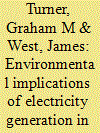

|
|
|
|
|
| Publication |
2012.
|
| Summary/Abstract |
Long-term, integrated modelling of electricity generation capacity and its operational requirements is important for coherent energy policy because of the multi-decadal lifespan of such plant, and because related fuel requirements, water consumption, and greenhouse gas emissions impact other sectors. This paper describes a physical model of electricity generation designed for long-term simulations, including the reproduction of decades of historical data, and its application to key policy questions. The simulation uses a dynamic, physical input-output model for the basic material and energy industries, embedded in an economy-wide stocks and flows framework (SFF). The historical reproduction, illustrated for the state of Victoria, is based on integrating bottom-up technical data on physical processes as inputs, and validating output against top-down aggregate data. We show that while greenhouse gas emissions would decrease significantly with the aggressive introduction of cleaner generation technology, long-term reductions are difficult to maintain against ongoing growth in consumption. Additionally, our sensitivity analysis identifies the importance of rapid action due to the age structure of operating power stations. We also identify significant imposts of alternative power generation on land and water resources, though a business-as-usual scenario would impose greater losses of water resources.
|
|
|
|
|
|
|
|
|
|
|
|
|
|
|
|
| 14 |
ID:
104921


|
|
|
|
|
| Publication |
2011.
|
| Summary/Abstract |
This study deals with the estimation of emissions caused by vehicular traffic based on transport demand and energy consumption. Projected transport demand is calculated with Genetic Algorithm (GA) using population, gross domestic product per capita (GDPPC) and the number of vehicles. The energy consumption is modelled with the GA using the veh-km. The model age of the vehicles and their corresponding share for each year using the reference years is obtained. The pollutant emissions are calculated with estimated transport and energy demand. All the calculations are made in line to meet the European standards. For this purpose, two cases are composed. Case 1: Emissions based on energy consumption, and Case 2: Emissions based on transport demand. The both cases are compared. Three policies are proposed to control demand and the emissions. The policies provided the best results in terms of minimum emissions and the reasonable share of highway and railway mode as 70% and 30% usage for policy I, respectively. The emission calculation procedure presented in this study would provide an alternative way to make policies when there is no adequate data on emission measurement in developing countries.
|
|
|
|
|
|
|
|
|
|
|
|
|
|
|
|
| 15 |
ID:
116990


|
|
|
|
|
| Publication |
2012.
|
| Summary/Abstract |
In 2008, Spain exceeded by 20.9% the CO2 emissions allowed by the Kyoto Protocol for 2012. The financial and economic crisis has transformed these figures: as production fell so did energy demand and with it CO2 emissions. Will the Spanish economic crisis allow Spain to fulfill its commitments? With this in mind, we have developed an extended input-output model able to forecast energy demand and compute CO2 emissions linked to the consumption of energy goods: petroleum products, gas and coal. The results show that the crisis, and in particularly, the stagnation of the construction industry, is only one of the pillars which help to contain these emissions at -6.81%. The possibility of incorporating environmental policies, new technologies and increases in the price of crude oil in these simulations, means an even greater reduction of emissions than the impact of the crisis (-9.76%). The final result of our most pessimistic/realistic scenario is that, in 2012, Spain will exceed its CO2 emissions, linked to the combustion of energy goods, by only 0.9%.
|
|
|
|
|
|
|
|
|
|
|
|
|
|
|
|
| 16 |
ID:
161825


|
|
|
|
|
| Summary/Abstract |
In this study, we attempt to empirically test the effects of air pollution on public health in China. Using three-stage least squares (3SLS) to solve the potential endogeneity problem in sulfur dioxide (SO2) emissions, we find that air pollution has significant negative effects on public health. Specifically, a 1% increase in SO2 emissions is found to lead to 0.067 and 0.004 more deaths per 100,000 population due to respiratory diseases and lung cancer, respectively. In terms of absolute magnitude, every one million ton increase in SO2 emissions results in 0.735 and 0.052 extra deaths due to respiratory diseases and lung cancer per 100,000 population, respectively. Moreover, SO2 emissions result in 230,000 extra deaths every year and the related economic costs over the study period amount to RMB 8.179 billion.
|
|
|
|
|
|
|
|
|
|
|
|
|
|
|
|
| 17 |
ID:
104914
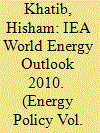

|
|
|
|
|
| Publication |
2011.
|
| Summary/Abstract |
The World Energy Outlook 2010 is a comprehensive energy report issued by the IEA. It is rewritten annually to reflect the world's changing energy and economy realities; it also introduces new issues relevant to the energy sector. This year it dealt with Caspian Energy, Energy Poverty and Energy Subsidies. WEO is controversial in few aspects; it still promotes a 450 Scenario which has become out of reach. This year however it introduced a more realistic New Policies Scenario which will need a lot of good will and investments to accomplish. Governmental policies are going to chart future energy sector performance; increasingly this is becoming decided by non-OECD countries. A more pragmatic future energy outlook is needed to reflect developing countries priorities for growth and utilization of local resources and how to accommodate this with abatement priorities through energy efficiency measures and technologies.
|
|
|
|
|
|
|
|
|
|
|
|
|
|
|
|
| 18 |
ID:
115173
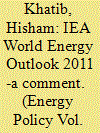

|
|
|
|
|
| Publication |
2012.
|
| Summary/Abstract |
There are increasing numbers of annual and periodical energy studies that look into future energy demand and sustainability issues. Among these the World Energy Outlook stands out as the most important futuristic energy study and analysis. The 2011 Outlook is in four parts and gives a full update of energy demand and supply projections to 2035. It analyses the possible evolution of energy markets under three scenarios. The core scenarios rest on common assumptions about macroeconomic conditions and population growth, while their assumptions about government policy differ. This year's Outlook offers an in-depth analysis of prospects for energy supply and use in Russia. It also provides an expanded assessment of the prospects for coal. It reviewed the future of nuclear energy after Fukushima, as well as the strategic challenges of energy poverty. Last it dealt with the important aspect of energy subsidies. In spite of its extensiveness and in depth analysis some of the Outlook assumptions and conclusions need careful analysis and review.
|
|
|
|
|
|
|
|
|
|
|
|
|
|
|
|
| 19 |
ID:
132609
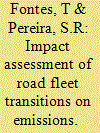

|
|
|
|
|
| Publication |
2014.
|
| Summary/Abstract |
This paper aims to examine the impacts of fleet composition changes on emission due to the introduction of different road transportation policies in a medium size European country (Portugal) applying an ex-post analysis (e.g. policies based on fuel pricing, car scraping, car taxation). A baseline scenario was compared with a counterfactual scenario in order to understand what would occur in the absence of the introduction of those policies. For each scenario, four approaches were assessed using economic effects and/or human health costs. HC, CO, NOx, PM and CO2 emissions from passenger cars and light duty vehicles were evaluated. The results show high statistical significance (p?0.05) between CO emissions and different vehicle features as vehicle age, fuel type and engine classes. The same pattern was observed between the average vehicle age and HC, NOx and PM. After the implementation of road traffic policies, the average emission factors of the fleet decreased 28-62% for HC, CO, NOx, PM and 20-39% for CO2. However, if a counterfactual scenario would be implemented, the reduction would be 20-80% and 26-55% higher, respectively. The results demonstrates that although were recorded some benefits, the fleet characteristics distribution were more environmental friendly in 2001 than in 2011.
|
|
|
|
|
|
|
|
|
|
|
|
|
|
|
|
| 20 |
ID:
135485
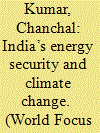

|
|
|
|
|
| Summary/Abstract |
India has multiple reasons for responding to climate change – it is highly vulnerable to the impacts of climate change, it is becoming more and more dependent on imported fossil fuels and it has the ability to take advantage of the economic opportunities and climate finance that is now available. It also places high importance on preserving ecosystems and its unique biodiversity.
|
|
|
|
|
|
|
|
|
|
|
|
|
|
|
|
|
|
|
|
|